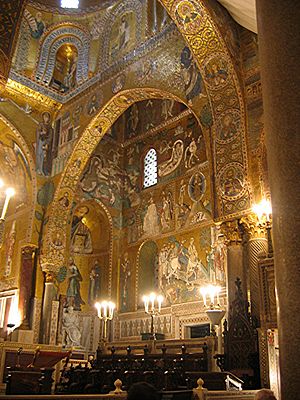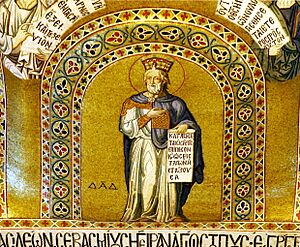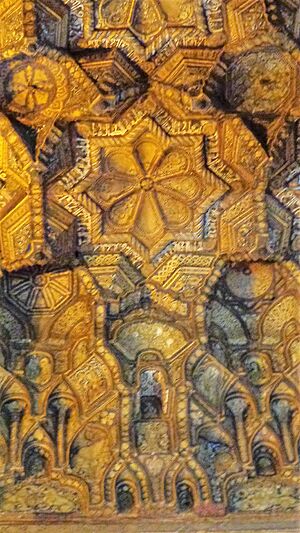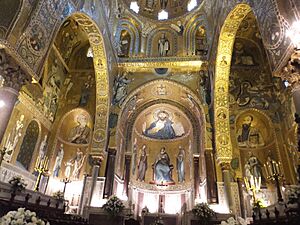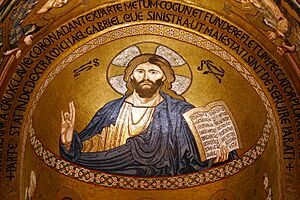Cappella Palatina facts for kids
The Palatine Chapel (called Cappella Palatina in Italian) is a special royal chapel. It is found inside the Norman Palace in Palermo, Sicily. This amazing building mixes different styles of architecture. You can see Byzantine, Norman, and Fatimid designs. This mix shows how Sicily had three main cultures in the 1100s. This was after Roger I and Robert Guiscard took over the island.
King Roger II of Sicily asked for this chapel to be built in 1132. It was built on top of an older chapel, which is now the crypt. It took eight years to build. The chapel was officially opened in 1132. The beautiful mosaics were still being finished in 1143. This chapel is dedicated to Saint Peter. It looks like a church with a dome. It has three apses, which are rounded ends, common in Byzantine buildings. Six pointed arches inside rest on old columns. The special muqarnas ceiling and the chapel's shape show the Fatimid influence.
The Palatine Chapel is part of a UNESCO World Heritage site. This site is called "Arab-Norman Palermo and the Cathedral Churches of Cefalù and Monreale". It was recognized in 2015.
Contents
Amazing Mosaics
The mosaics in the Palatine Chapel are very elegant. The figures in them are tall and have flowing clothes. Their colors and light also change in a subtle way. The oldest mosaics are probably on the ceiling, the drum, and the dome. The sparkling mosaics in the transept are from the 1140s. They were likely made by Byzantine artists. One scene on the north wall shows St. John in the desert. Another shows a landscape with the Agnus Dei (Lamb of God).
Below this, there are five saints. These are important Greek church leaders. They include St. Gregory of Nissa and St. John Chrysostom. The three main figures are known as the Three Hierarchs. Each mosaic picture has a decorative frame. This is similar to frames used for icons from that time.
Other mosaics were made later, around the 1160s or 1170s. These are made in a simpler style. They have Latin writing instead of Greek. Local artists probably made these. These mosaics tell more stories and are less about spiritual ideas. Some mosaics show everyday life. They have pictures of plants and animals from the Middle East. This might be the only large example of non-religious Byzantine mosaics still existing today.
The Muqarnas Ceiling
The amazing muqarnas designs in Italy are all in Palermo. You can see them in the Zisa Palace and the Palatine Chapel. These are rare examples of muqarnas not found in Islamic buildings. They appeared in Sicily quite suddenly. This means such a complex style was probably brought from somewhere else. Experts are not sure where this art came from. Ideas include North Africa, Egypt, Syria, Persia, or even Sicily itself.
Some people think it came from North Africa. They point to similar designs in Algeria. There are also muqarnas in Tunisia that look like those in the Palatine Chapel. Another idea is Syria, where the earliest muqarnas are from the 1100s. Many Syrian styles look like the Sicilian ones. However, the Sicilian muqarnas are about 30 years older than the Syrian ones.
Some believe the muqarnas came from the Fatimids in Egypt. There might have been problems in Cairo. This could have made Fatimid artists move to Sicily. This might have led to Sicilians and Fatimids working together. The Fatimids then could have brought muqarnas with them. A newer idea is that skilled Islamic artists were already in Sicily. They might have created the muqarnas there. This is because Sicilian muqarnas are quite different from other Islamic ones. However, the main idea is that the Fatimids started the Sicilian muqarnas. But there is not much clear proof. So, where muqarnas in Sicily came from is still a mystery.
The muqarnas ceiling covers the main hall in the western part of the chapel. This ceiling shows the many cultures in King Roger II's kingdom. It also shows how he could unite different groups. Some experts say Roger had the ceiling made of wood. This was to remind people of King Solomon's palace in Jerusalem. This would suggest Roger had a special right to rule. The art helps show Roger and his family as true royalty. The art is linked to the Islamic idea of a perfect paradise. This suggests the Norman Kings were like representatives of heaven on Earth. The ceiling shows how Mediterranean and Islamic traditions mixed. It does this through writings, pictures, and shapes.
There are about 75 writings on the ceiling. They are like prayers for the king's power. They offer blessings for power, wealth, goodness, and health. Many of these writings are in Kufic script. This supports the idea of Fatimid origins, as they used this script. The writings were hard to read because of the art and shapes. But people could make out a word or two. This could remind them of a verse from the Quran.
The pictures on the muqarnas continue the idea of paradise. The images show fun activities from the king's court. There are hunters, people drinking, dancers, and musicians. Interestingly, the pictures on the ceiling do not tell one clear story. On the eastern end of the muqarnas ceiling, there are pictures of people singing, dancing, and drinking. These seem to be part of a party for the chapel's supporters. These people are holding special drinking cups. These cups appear all over the muqarnas. Then, on the third level, there are two paintings of crowned rulers. One of these is King Roger II. There are also some Christian scenes on the muqarnas. But they show everyday life, not always religious events. The muqarnas also celebrate battles and hunts. They show many animals like elephants, deer, and antelopes. In Arab stories, animals often have deeper meanings.
The Palatine Chapel has the oldest known wooden muqarnas. It is likely that wooden muqarnas started with this building. Earlier examples were made of bricks or stones. The wooden muqarnas ceiling was probably built after the mosaics in the nave. King William I ordered these mosaics. The wooden pieces are very small, about 1 to 1.5 centimeters. Each piece fits together. They are held with fiber ties and animal glue. The ceiling is supported by wooden moldings. These moldings touch the top of the windows. The ceiling has a balanced design. It has a central part with a star and cross pattern. The muqarnas has five levels. These levels help the ceiling smoothly connect to the walls. The main parts of the ceiling are 20 eight-pointed stars. These stars are made by putting two squares on top of each other at an angle. These stars are inside eight-sided shapes. Smaller eight-pointed stars are placed between the main stars. The ceiling plays with shapes and light. The muqarnas are not for holding up the building. They hang below the outer roof, held by more wood.
The Chapel's Design
The chapel beautifully combines different styles. It has Norman architecture and door decorations. It has Arabic arches and ceiling designs. It also has Byzantine domes and mosaics. For example, groups of four eight-pointed stars are on the ceiling. These are common in Muslim design. But they are arranged to form a Christian cross.
The Palatine Chapel is built facing east and west. The king's throne was on the west side. The main church area is on the east side. The nave connects these two parts. There are domes over each side. Along the north wall of the church area is the royal balcony. This is where the King would watch church services on special days. Two rows of columns run along the nave. Windows are placed between each column. The chapel was decorated with gold, pearls, and marble.
The chapel is seen as a mix of a Byzantine church and a Western church. The church area has an "Eastern" artistic feel. The nave, or main hall, shows "Western" influences.
The nave was built under King Roger II. It did not have any Christian images at first. These were added later by Roger II's sons, William I and William II. The nave's ceiling has Arabic, Greek, and Latin writings.
The frame for the royal throne is against the west wall of the nave. Six steps lead up to where the throne would be. There are also two lion pictures above the throne frame.
The nave had different decorations on its north and south sides compared to its east and west sides. Detailed patterns from the ceiling outline the arches in the north and south. These outlines have oval medallions and decorative frames. In the east and west, the decoration is similar to the muqarnas ceiling. But it is missing some of the border moldings.
The Sanctuary (Church Area)
The sanctuary shows Norman culture. St. Dionysius and St. Martin are pictured there. The mosaics are Byzantine in their style and what they show. At the very top of the dome is the Pantokrator. This is a picture of Christ as ruler of all. Around him are rows of angels, prophets, and saints. The Byzantine style ends with scenes from Christ's life. These are along the south wall. The north wall shows warrior saints.
Important People
- Giuseppe Bertini (1759–1852) was the music director at the Palatine Chapel from 1794 to 1852. Before that, he was the assistant music director under his father, Salvatore Bertini.
See also
- Arab-Norman Palermo and the Cathedral Churches of Cefalù and Monreale
- History of medieval Arabic and Western European domes


